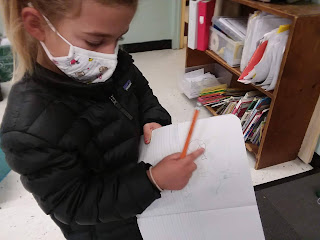For science we are in the midst of a unit on structure, function, and design. We began this unit by talking about objects designed by people and the idea that most man made objects have a specific structure, which is directly related to their function. We closely looked at a students' bike helmet and talked about its shape and the materials used to make it, and how these were connected to the intended function of protecting someone's head. We noticed the helmet was hard plastic on the outside, with foam on the inside. It was round so it could closely and comfortably fit on a person's head (we briefly imagined what it would be like to have a cube shaped helmet!) and it had a convenient clip strap to help keep it on, especially helpfully when in motion. We talked about the structure and function of several other objects before engaging in our first design challenge.
After reading the book "Jack and the Beanstalk," we talked about the function of the beanstalk for Jack and looked at its structure, noticing the characteristics that made it particularly useful for climbing. Students were given the challenge to use 10 pipe cleaners (and nothing else) to build the tallest beanstalk they could. Students were given a chance to ask questions and brainstorm answers about aspects of the challenge that might be difficult, including "What? We can't use tape?" and "How are we supposed to make it stand up?" Before building we also talked about the notion of perserverence and how important it would be to not give up, be willing to work through challenges, and try new ideas if the first design didn't work.
Once they began building children quickly realized a strong base was critical for getting the beanstalk to stand up, which meant less height overall. Balance was also essential, especially if they took the challenge of having the beanstalk hold a golden egg when it was complete!
I especially love this activity because, while it almost always pushes some children to the limits of their frustration, this gives other children an opportunity to offer encouragement and share their great ideas.






















